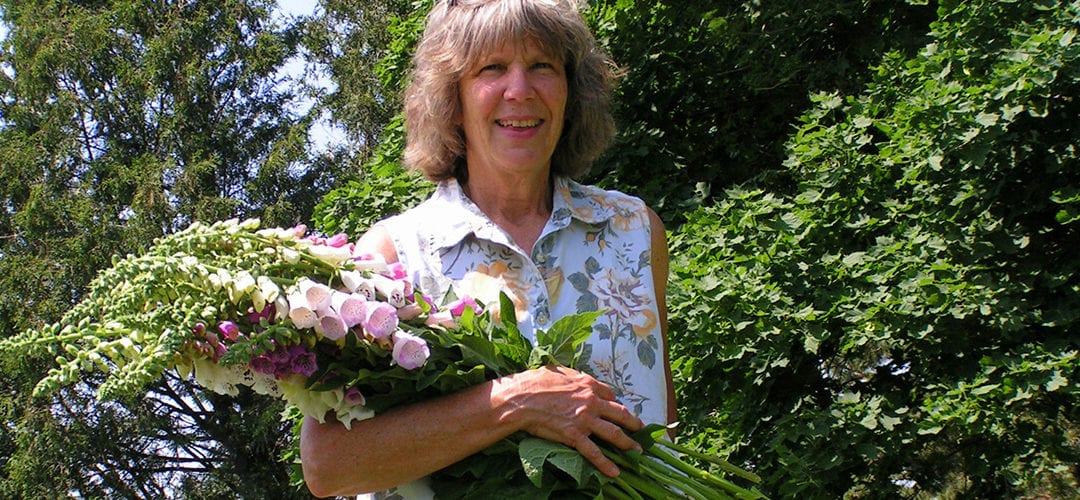One might think it’s impossible for supermarket shoppers to find truly “local” flowers during all four seasons of the year, especially in the Windy City. But those who frequent several Whole Foods Market floral departments in Chicago have Jeanie McKewan, of Brightflower Farm, to thank for a high-quality selection of Illinois-grown blooms and bunches – among other botanical options even in colder months.
“Brightflower Farm supplies Illinois-grown flowers, bouquets and plants to Chicago-area Whole Foods Market stores.”
In its 13th growing season, Brightflower Farm is located in Stockton, Ill., about 135 miles west of Chicago. As co-founder of Brightflower Farm, McKewan provides uncommon cut flowers to her grocery customers, as well as to a select group of Chicago wedding and event designers. Over the years, this engaging flower entrepreneur has produced edible crops and ornamentals for the landscape. But she is at her best when swimming in a rainbow of waist-high annuals and perennials that line her fields and fill her greenhouses.
“Annually, we grow and sell more than 150,000 stems of flowers, including peonies and Dahlias, mixed bouquets and consumer bunches, as well as ornamental grasses and woody stems,” she says. Much of that abundance is destined for Brightflower’s primary markets in Chicago and cities in Wisconsin.
In 2009, the farm caught the attention of Katie O’Connor, former lead floral buyer for Whole Foods’ Midwest region, when she was introduced to McKewan through a mutual acquaintance. O’Connor made a first-person visit to Brightflower Farm and was hooked, the flower farmer recalls.
“Kate saw what I was growing, and she was amazed with the quality,” McKewan says. “She liked my quality, she liked me – and she gave me a chance.” That connection helped to launch Brightflower’s successful run with Whole Foods Market, and encouraged the flower farmer to expand her floral quantities and varieties.
McKewan initially supplied Whole Foods’ original Lincoln Park store with Illinois-grown flowers and certified organic herb plants. Today, through direct-to-store deliveries, sales to Whole Foods Market account for more than 50 percent of Brightflower Farm’s annual revenue.
McKewan’s relationship with Whole Foods has adapted with changes in her farm’s crop availability and business model. After supplying the regional distribution center in 2015 and 2016, McKewan returned to her preferred direct-delivery model, working with about six Chicago-area Whole Foods outlets. Each store’s floral specialist orders on a weekly basis, choosing inventory from Brightflower’s availability list. The farm produces a weekly order guide that features mixed bouquets, consumer bunches (5- or 7-stem bunches of a single flower type), and Brightflower’s popular Mason jar bouquets and succulent planters (4-, 6- and 8-inch clay pots with unusual succulents, topped with recycled, decorative glass).
Bunches and bouquets are labeled with Brightflower Farm branding, which is repeated in Whole Foods’ “Illinois Grown” point-of-purchase signage.
McKewan says that the direct-to-store relationship allows each buyer to personalize his or her flower selection, and gives more creativity to both flower farmer and flower buyer. “Even my delivery days can be somewhat flexible; for example, if one store has a wedding order, I can tweak the delivery day or quickly add more product,” the farmer explains.
Brightflower’s fashion-forward stems are harvested one day and delivered the next – freshness that ensures customer satisfaction and repeat sales. There are pros and cons to growing cut flowers at the edge of the ‘Driftless Region’ – a part of Illinois and Wisconsin formed millennia ago by glaciers. The soil is excellent – 60 feet of topsoil that’s perfect for farming flowers – but the seasons are a challenge. Brightflower Farm is located in USDA Zone 5a (minimum average temperatures of negative 20 F to negative 15 F), which means there is a definite “off-season” for field-grown crops.
“I’ve had to develop strategies for extending the seasons, such as installing a big greenhouse where I can grow during the winter,” McKewan explains. Two hoop houses provide shelter from frost and snow, allowing the farm to produce semi-hardy herbs such as lavender, rosemary, scented geranium and Salvia on a nearly year-round basis.
At the peak of season, Brightflower Farm often makes twice-weekly deliveries to Chicago, tailoring the route its driver takes to hit each Whole Foods store’s delivery window. Adding a second delivery day is a frequent request – one that McKewan accommodates with a two-case minimum.
For McKewan, the value of her farm-to-grocery relationship with Whole Foods offers the potential to go beyond the stores. “I probably never would have gotten into the Chicago market without my Whole Foods customers. It’s a very important piece of my business, and it gives me a reason to pursue florists in that market, too,” she explains.
DETAILS
Brightflower Farm: brightflowerfarm.com, @brightflowerfarm

Debra Prinzing is a Seattle-based writer, speaker and leading advocate for American Grown Flowers. She is the producer of slowflowers.com. Each Wednesday, approximately 2,500 listeners tune into her “Slow Flowers Podcast,” available for free download at her website, debraprinzing.com, or on iTunes and via other podcast services. In 2016, GWA: The Association for Garden Communicators inducted her into its Hall of Fame. She is the author of 10 books, including Slow Flowers and The 50 Mile Bouquet.







